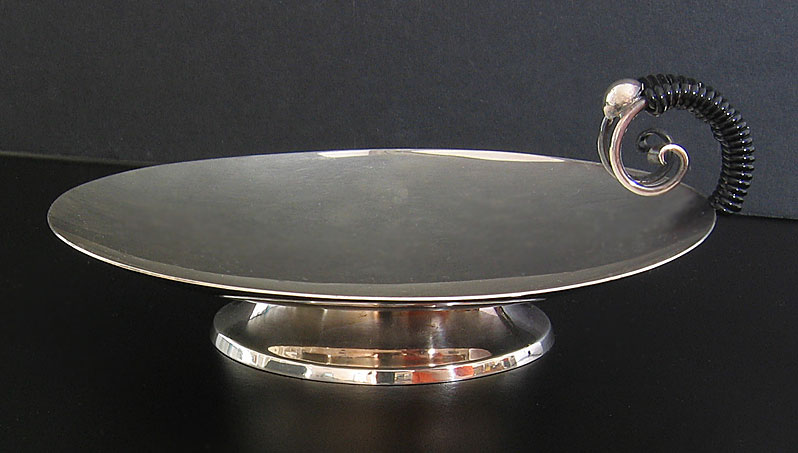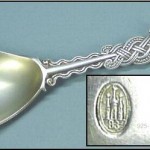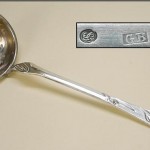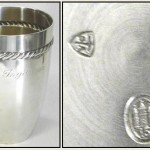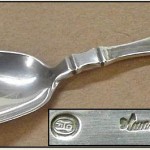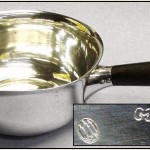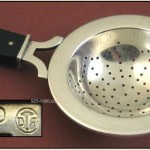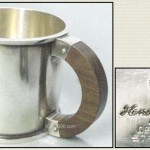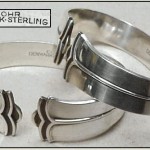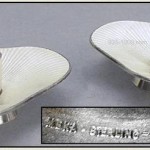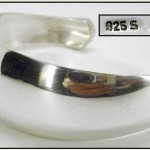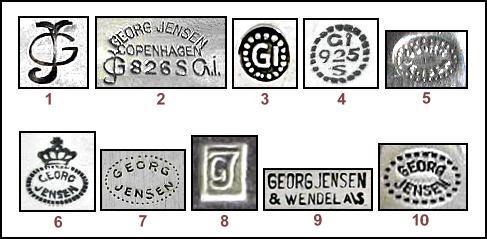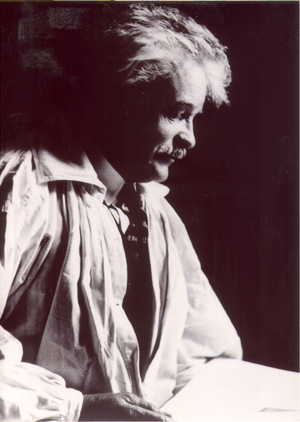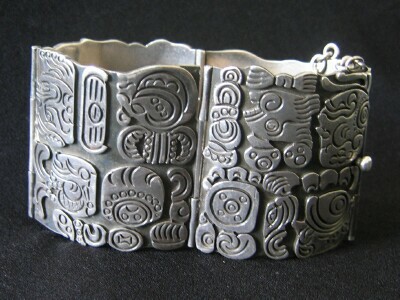- A souvenir spoon by A. Fleron, Copenhagen 1893, the assayer’s mark SG for Simon Groth. No numerical standard mark, the “three tower” mark guaranteed it to be a minimum of .826 silver.
- Simon Groth. No numerical standard mark, the “three tower” mark guaranteed it to be a minimum of .826 silver.
- Gilt sterling and enamel sugar tongs by Peter Herz, Copenhagen. Marked only with maker’s mark and 925S. These could have been made any time from c.1895 until the 1930s, Herz was a crown jeweler, the name was enough to guarantee confidence. Probably made for export.
- An Arts & Crafts beaker, unknown maker & location, year 1915 with the assayer’s mark CFH for Christian F. Heise. The “D Hammer A” mark in the shield shaped cartouche is for the Dansk Arbedje, a Danish trade association that promoted Danish consumerism of Danish products, it is not a maker’s mark. No numerical standard mark, the “three tower” mark guaranteed it to be a minimum of .826 silver.
- A silver sugar spoon by Hans Hansen of Kolding, year 1932, stamped with the assayer’s mark of Christian F. Heise. No numerical standard mark.
- A silver and ebony saucepot by Carl M. Cohr of Fredericia, 1934 with the assayer’s mark JS for Jens Sigsgaard. No numerical standard mark.
- A silver and bakelite tea strainer by Carl M. Cohr of Fredericia, c.1936. It also carries the Dansk Arbedje mark as well as .830S for the silver standard.
- A sterling & rosewood mug by Hans Hansen of Kolding, “in house” year mark for 1949. Marked – Sterling & Denmark.
- Sterling “Sparta” pattern napkin rings by Carl M. Cohr of Fredericia, c.1950s. Marked – Sterling & Denmark.
- Sterling & enamel tapersticks by Meka of Holte, c.1960. Marked – Meka, Sterling, Denmark 925S.
- Sterling cuff bracelet by Andreas Mikkelsen, Copenhagen c.1975. Marked – A. Mik 925S.
In 1893, a law was enacted in Denmark that standardized a new system of silver marking. Required were: Maker’s Mark, Numerical Standard Mark, Assay Mark (three tower), and Assay Master’s Initial Mark. The minimum standard of silver purity was .826, this was amended to .830 in 1936 and .925 became the other official standard, although it had been commonly used before, especially on silver made for export.
If one examines the marks on many pieces of 20th century Danish silver, it becomes apparent that adherence to the marking law was either at the discretion of the maker or very lax in enforcement. Many of the larger firms such as George Jensen, Hans Hansen & Carl Cohr, rarely had official assay marks on their silverware and jewelry, no doubt these names inspired trust and their customer base did not require the added credence of state control marks. However, smaller firms and individual silversmiths did tend to follow the law, as official state marking did inspire confidence in their customers.
As the 20th century progressed, the official state hallmarks are found less and less, they were officially retired in 1977, it had already become common practice for pieces to be marked only with the maker’s intials, 925S and sometimes Sterling and “Denmark”.
Below are twelve examples of Danish silver illustrating the common variations of marking through the century, they are in sequential order from 1893 to c.1975.
Danish Assay Marks
The “Three Tower Mark” was instituted in 1608 as the official city mark of Copenhagen. Other Danish cities (e.g. Aalborg, Aarhus, Odense, Viborg) had their own marks until 1893 when the Copenhagen Three Towers became the national mark for Denmark. This mark guarantees a silver purity minimum of 826/1000 (unless a higher standard mark is indicated). Each year the design of the mark was slightly changed – making it unique, the numbers below indicate the year (four digits were used until 1771, two digits after, with a few exceptions). The Three Towers were always marked in conjunction with the initial mark of the Assay Master (Stadtsguardein), it was he who took final responsibility of guarantee. The use of both marks was discontinued by 1977.
(note: the last mark illustrated, the two towers, was used only on silverplated ware ca.1890s to 1930s)
GEORG JENSEN
Born in 1866, the son of a knife grinder in the town of Raadvad just to the north of Copenhagen. Jensen began his training in goldsmithing at the age of 14 in Copenhagen. His apprenticeship, with the firm Guldsmet Andersen, ended in 1884 and this freed young Georg to follow his artistic interests.
From childhood, Jensen had longed to be a sculptor and he now pursued this course of study at the Royal Academy of Fine Arts. He graduated in 1892 and began exhibiting his work. Although his is clay sculpture was well received, making a living as a fine artist proved difficult and he turned his hand to the applied arts. First as a modeller at the Bing & Grondahl porcelain factory and, beginning in 1898, with a small pottery workshop he founded in partnership with Christian Petersen. Again the work was well received, but sales were not strong enough to support Jensen, by this point a widower, and his two small sons.
In 1901, he abandoned ceramics and began again as a silversmith and designer with the master, Mogens Ballin. This led Jensen to make a landmark decision, when in 1904, he risked what small capital he had and opened his own little silversmithy at 36 Bredegade in Copenhagen.
Jensen’s training in metalsmithing along with his education in the fine arts allowed him to combine the two disciplines and revivify the tradition of the artist craftsman. Soon, the beauty and fine quality of his Art Nouveau creations caught the eye of the public and his success was assured. The Copenhagen quarters were greatly expanded and before the close of the 1920’s, Jensen had opened retail outlets as far ranging as New York, London, Paris, Stockholm, Berlin and Buenos Aires.
Georg Jensen died in 1935, but in the preceding years he imbued the firm with his strongly held ideals concerning both artistry in design and excellence in craftmanship, this tradition has been adhered to throughout the 20th century. Although Jensen himself was a proponent of the Art Nouveau style, he had the wisdom and foresight to allow his designers their own freedom of expression which expanded the stylistic scope of what the firm produced and allowed it to keep step with time.
1 • used 1904 ~ 1908
2 • used 1909 ~ 1914
3 • circa 1910 ~ 1925
4 • used 1915 ~ 1930
5 • used 1915 ~ 1927 (raised lettering)
6 • used 1925 ~ 1932
7 • used c.1930’s on holloware (engraved lettering)
8 • used 1933 ~ 1944
9 • used 1945 ~ 1951 on items retailed in Copenhagen
10 • used 1945 ~ Present (intaglio lettering)
On occasion, designer’s marks are found alongside the Jensen maker’s mark. Some of the firm’s more notable designers include:
- Gundolph Albertus (1887-1970)
- Sigvard Bernadotte (1907-2002)
- Nanna & Jorgen Ditzel (JD – d.1961)
- Nanna Ditzel (1923-2005)
- Bent Gabrielsen (b.1928)
- Henning Koppel (1918-1981)
- Arno Malinowski (1899-1976)
- Harald Nielsen (1892-1977)
- Johan Rohde (1856-1935)
- Vivianna Torun Bulow-Hube (1927-2004)
Johan Rohde (1856-1935)
Gundolph Albertus (1887-1970)
Harald Nielsen (1892-1977)
Arno Malinowski (1899-1976)
Sigvard Bernadotte (1907-2002)
Henning Koppel (1918-1981)
Bent Gabrielsen (b.1928)
Nanna & Jorgen Ditzel (JD – d.1961)
Nanna Ditzel (1923-2005)
Vivianna Torun Bulow-Hube (1927-2004)

